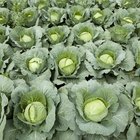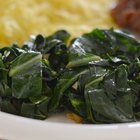YelenaYemchuk/iStock/GettyImages
Cabbage is a superlative vegetable in many respects. It's inexpensive, nutritious and versatile and keeps well whether fresh or preserved. Its only real shortcoming is the distinctively unpleasant odor it often generates when it's cooked. That pungent odor, a longtime signature of immigrant neighborhoods in many cities, is caused by some of the sulfur compounds found in the cabbage. Its effect can be minimized by careful cooking.
The Best Defense
It's a common aphorism that the best defense is a good offense, so it's only appropriate that the offensive smell of cooking cabbage derives from its chemical defenses. Like the onion family, plants in the cabbage family defend themselves with an array of sulfur compounds. Sulfur bonds freely with many other substances, lending its distinctive odor to the resulting molecules. Within common members of the family, green cabbage is second only to Brussels sprouts in its sulfur content. When it's boiled or simmered for an extended period, sulfur compounds in the cabbage are converted into extremely pungent molecules called trisulfides. They're the culprits that leave your house smelling of cabbage after the meal.
Boiling Without Regrets
If you're partial to boiled cabbage but don't care for the odor, quick cooking is the answer to your dilemma. Cut the cabbage into thin slices or wedges, no more than 1/4 inch in thickness, so they'll cook to a tender texture in just a few minutes. Drop them into a pot of boiling water, then adjust the temperature so it returns to a simmer rather than a full boil. Hard boiling speeds the development of trisulfides, while gentle simmering minimizes it. Cook the thin-sliced cabbage for 10 to 15 minutes, until it's just barely tender. Drain it and serve it immediately, or chill it in ice water and then drain and wrap it for later use.
A Head of Steam
An alternative cooking method is steaming the cabbage. This gives an end result that's similar to boiled cabbage, but also minimizes the production of nostril-offending trisulfides. Cut the cabbage into pieces approximately 1/4 inch in thickness, or into long fine shreds if you prefer. Arrange the cabbage evenly in the basket of an electric steamer or the steamer insert of a large pot. Steam shredded cabbage for 5 to 7 minutes, until just tender. Quarter-inch wedges will take slightly longer, roughly 10 to 12 minutes.
A Sour Disposition
If you love the buttery-soft texture of long-cooked cabbage but don't want to remember it every time you walk into the house, there is one way to beat the odor and still enjoy long-cooked cabbage. Acidity inhibits the formation of the offensive trisulfides, which is why traditional European recipes often call for the use of wine and vinegar. Simmer the shredded cabbage gently for an hour or more in your choice of apple juice, cider, white wine or water and wine vinegar, using just enough liquid to cover the cabbage. When the cooking liquid has cooked away, serve the tender and richly flavored cabbage with your favorite meat dish.
Related Articles

Nutritional Value of Cabbage

How to Steam Cook Cabbage

Nutrients for Steamed Broccoli

How to Steam Cabbage on the Stove

How to Blanch Bitter Greens for Italian ...

Steamed or Boiled Cauliflower

How to Blanch Cabbage
How Do I Cook Cabbage on the Stove Top?

How to Cook Collard Greens Without Meat

How to Get Rid of Skunk Smell With ...

How to Cook Mixed Greens

How Long Does It Take to Steam a Yam?

How to Wash a Navy Sailor Hat
How to Clean and Cook Broccoli Rabe

How to Cook Corned Silverside in a Slow ...
How to Cook Cut Moringa Drumsticks

How to Cook Tripe

How to Cook Cabbage & Noodles in a ...

Ways to Cook Broccoli

How to Blanch Spinach
References
- On Food and Cooking: The Science and Lore of the Kitchen; Harold McGee
- Recipe Tips: All About Cabbage
- The Old World Kitchen: The Rich Tradition of European Peasant Cooking; Elizabeth Luard
Writer Bio
Fred Decker is a trained chef and prolific freelance writer. In previous careers, he sold insurance and mutual funds, and was a longtime retailer. He was educated at Memorial University of Newfoundland and the Northern Alberta Institute of Technology. His articles have appeared on numerous home and garden sites including GoneOutdoors, TheNest and eHow.